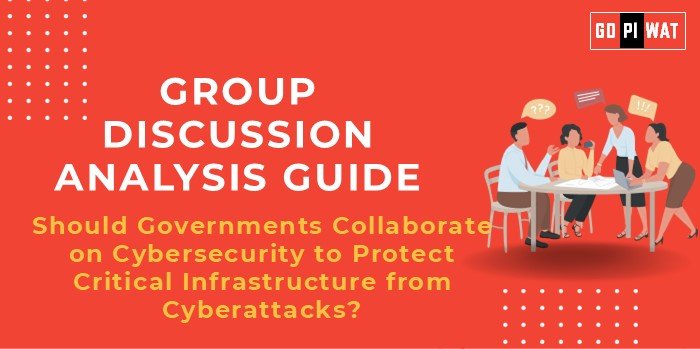📋 Group Discussion (GD) Analysis Guide: Should Governments Collaborate on Cybersecurity to Protect Critical Infrastructure from Cyberattacks?
🌐 Introduction to the Topic
- Opening Context: With cyberattacks targeting essential infrastructure like energy grids, healthcare systems, and financial institutions, the question of international collaboration in cybersecurity has gained urgent significance.
- Topic Background: The rise of cyberattacks, such as ransomware targeting hospitals or supply chain disruptions, has underscored the vulnerability of critical infrastructure. Recent incidents like the 2022 Colonial Pipeline attack and the SolarWinds hack demonstrate that cybersecurity is a global concern demanding cooperative solutions.
📊 Quick Facts and Key Statistics
• 🌍 Global Cybercrime Cost: Expected to hit $8 trillion by the end of 2024 (Cybersecurity Ventures).
• 💻 Critical Infrastructure Attacks: 50% increase globally in 2023, targeting healthcare and energy sectors (IBM X-Force).
• 🤝 Government Collaboration: 70+ countries have signed the Paris Call for Trust and Security in Cyberspace, emphasizing joint efforts.
• ⚠️ Preparedness Gap: 60% of critical infrastructure organizations are unprepared for significant cyberattacks (World Economic Forum, 2024).
• 💻 Critical Infrastructure Attacks: 50% increase globally in 2023, targeting healthcare and energy sectors (IBM X-Force).
• 🤝 Government Collaboration: 70+ countries have signed the Paris Call for Trust and Security in Cyberspace, emphasizing joint efforts.
• ⚠️ Preparedness Gap: 60% of critical infrastructure organizations are unprepared for significant cyberattacks (World Economic Forum, 2024).
🤝 Stakeholders and Their Roles
- 🏛️ Governments: Establish frameworks and fund cross-border initiatives for cybersecurity.
- 💡 Private Sector: Develop security tools, share threat intelligence, and secure supply chains.
- 🌐 International Organizations: Coordinate efforts through treaties and guidelines, e.g., ITU’s Global Cybersecurity Agenda.
- 👥 Citizens: Raise awareness and follow cybersecurity best practices to reduce vulnerabilities.
🏆 Achievements and ⚠️ Challenges
✨ Achievements
- European Union’s NIS Directive: Strengthened cooperation on cybersecurity across member states.
- Global CERT Collaboration: Shared threat intelligence reduced ransomware impact by 30% in 2023.
- US-Israel Partnership: Advanced AI tools for early threat detection.
⚠️ Challenges
- Sovereignty Concerns: Nations reluctant to share sensitive data.
- Resource Disparity: Developing nations lag in cybersecurity infrastructure.
- Mistrust: Political tensions hinder cooperation, as seen between the US and China.
💡 Structured Arguments for Discussion
- ⚖️ Supporting Stance: “Collaboration is the only way to address transnational cyber threats that do not respect borders.”
- 🔄 Opposing Stance: “National security concerns and the risk of espionage make international collaboration impractical.”
- 🌟 Balanced Perspective: “While collaboration can enhance resilience, it must be tailored to protect sovereignty and trust.”
🗣️ Effective Discussion Approaches
- Opening Techniques:
- Cite a high-impact case like the Colonial Pipeline attack.
- Discuss data on cybercrime growth rates.
- Counter-Argument Handling:
- Rebut sovereignty concerns with examples like the EU NIS Directive.
- Highlight cost-effective shared solutions through AI tools.
📈 Strategic Analysis of Strengths and Weaknesses
- Strengths: Cross-border threat intelligence, enhanced resilience, and cost savings.
- Weaknesses: Mistrust, data-sharing challenges.
- Opportunities: Public-private partnerships, capacity building in developing nations.
- Threats: Increasing sophistication of cybercriminals, geopolitical tensions.
📘 Connecting with B-School Applications
- Real-World Applications:
- Case studies on multinational cooperation for business continuity and risk mitigation.
- Sample Interview Questions:
- “How can businesses benefit from global cybersecurity collaborations?”
- “What lessons can governments learn from private-sector cybersecurity strategies?”
- Insights for B-School Students:
- Cybersecurity’s relevance to operations, risk management, and ethical decision-making.


